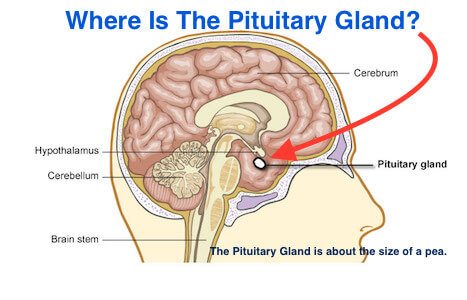Where Is The Pituitary Gland Located?

Where Is The Pituitary Gland Located?
The pituitary gland is located in the middle of the skull and is encased in a saddle-shaped box called the Sella Turcica.
The pituitary gland is a protrusion off the bottom of the Hypothalamus and is located underneath the brain and behind the bridge of your nose.
The pituitary gland is about the size of a large pea and weighs approximately .5 grams.
The gland is situated in a tight space and any abnormal growth, compression or head drama can result in damage to the pituitary gland.
The Pituitary Gland consist of three lobes: the Anterior, Immediate and Posterior
- The Anterior Lobe is located inside the pituitary gland
- The Intermediate Lobe is located between the Anterior Lobe and Posterior Lobe
- The Posterior Lobe is the outside portion of the Pituitary Gland
The posterior lobe connects to the Hypothalamus through a small tube called the Pituitary Stalk.
The Hypothalamus also connects with many other regions of the brain and is responsible for thirst, emotions, body temperature regulation, circadian rhythms and controlling hunger.
The Pituitary Gland releases numerous life vital hormones;
Pituitary Gland Hormones
- Prolactin – Prolactin stimulates breast milk production after childbirth.
- Growth hormone (GH) – Growth Hormone stimulates growth in childhood and is important to maintain a healthy body composition.
- Adrenocorticotropin (ACTH) – ACTH stimulates the production of cortisol by the adrenal glands. The adrenal glands are kidney sized glands that rest on top of the kidneys. Cortisol is vital to our survival. Cortisol allows the body to maintain blood pressure, blood glucose levels, and our body releases higher amounts of cortisol when the body is under stress of injury or sickness.
- Thyroid-stimulating hormone (TSH) – TSH stimulates the thyroid gland to produce thyroid hormones, which regulate the body’s metabolism, energy balance, growth, and nervous system activity.
- Luteinizing hormone (LH) – LH stimulates testosterone production in men and stimulates the egg release in women.
- Follicle-stimulating hormone (FSH) – FSH aids sperm production in men and stimulates the ovaries to produce estrogen and develop eggs in women.
- Antidiuretic hormone (ADH) – ADH, also called vasopressin. Vasopressin regulates water balance in the body.
- Oxytocin – Oxytocin causes milk production in women after childbirth. Oxytocin is also thought to help labor to progress. Low Oxytocin levels may make a person feel withdrawn.
I hoped this post help answers, “Where Is The Pituitary Gland Located?”
You can read about my HypoGal journey with Sheehan’s Syndrome, HERE.
Here is a list of my Pituitary Gland medication.
You may find these weblinks helpful:
If you would like to find out about Shortcuts to Living With A Chronic Illness then please read HypoGal Blog.
Please, Like, HypoGal on Facebook.
Click on the following link to find Sheehan’s Syndrome Support Groups.
If you would like to receive HypoGal’s updates and an 11 page Government Resource Guide then please submit your email address at the bottom of this page ↓

